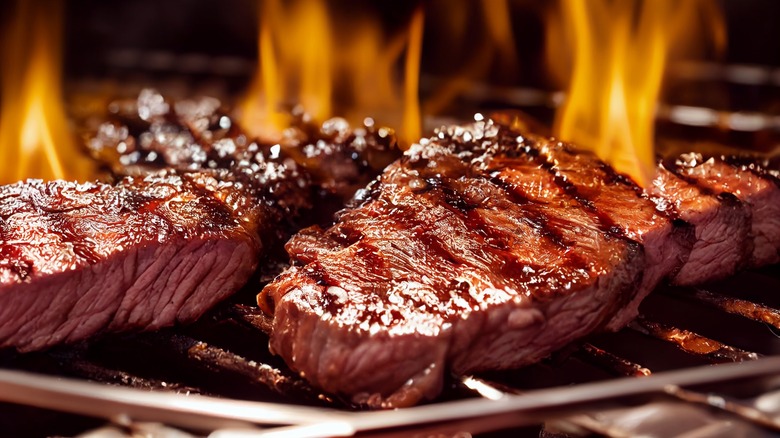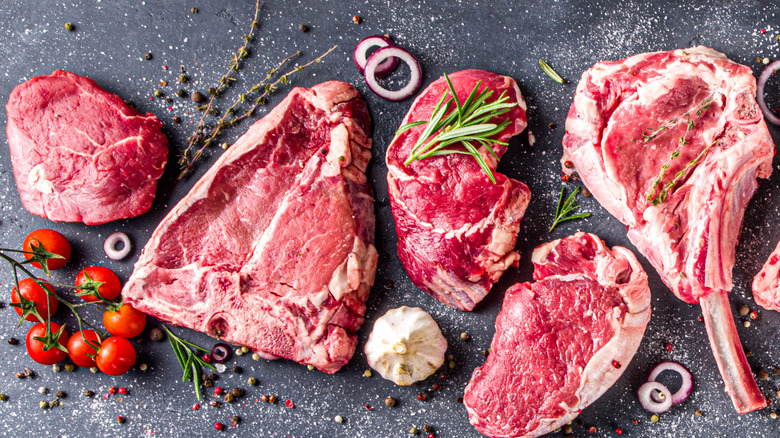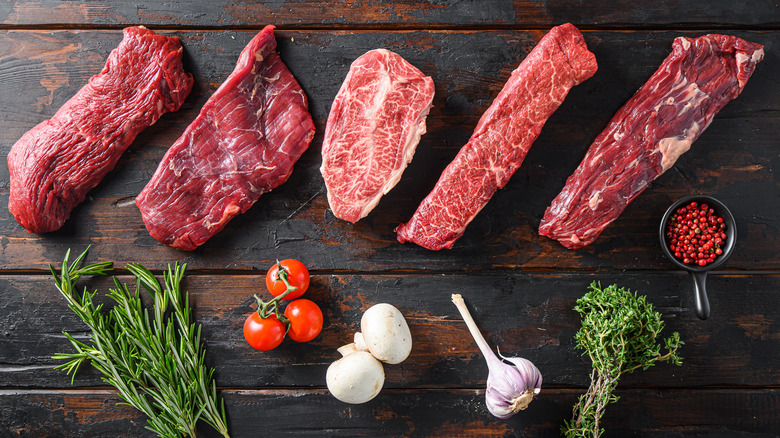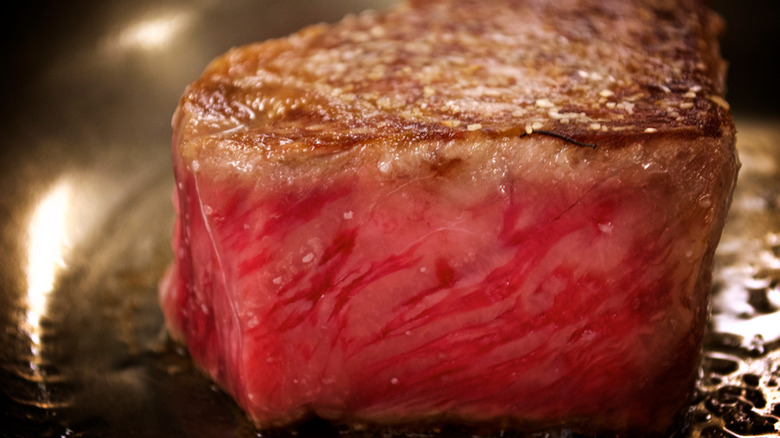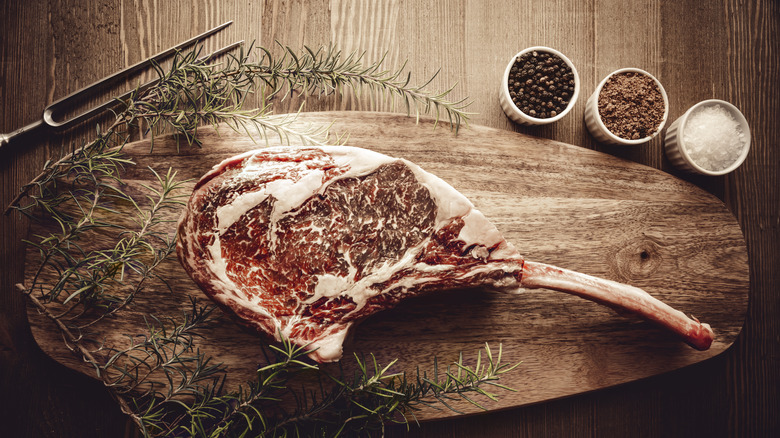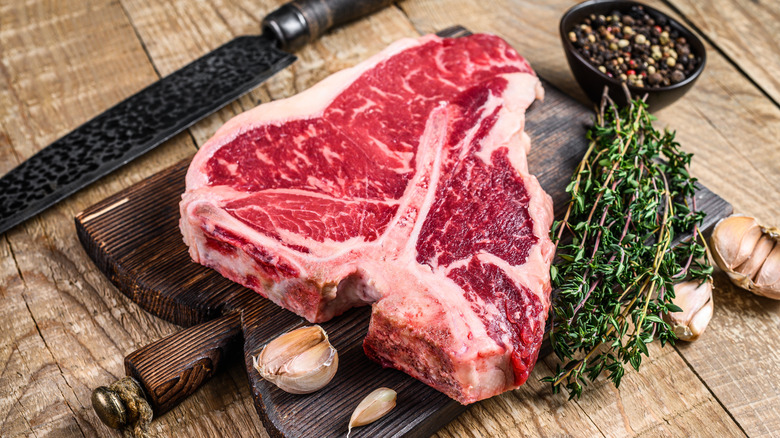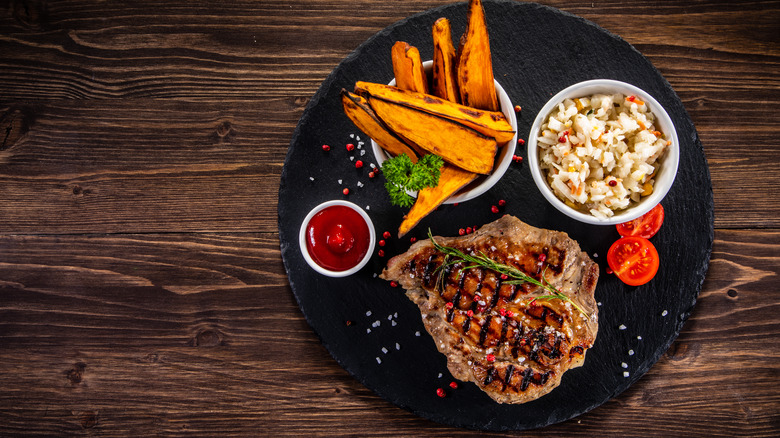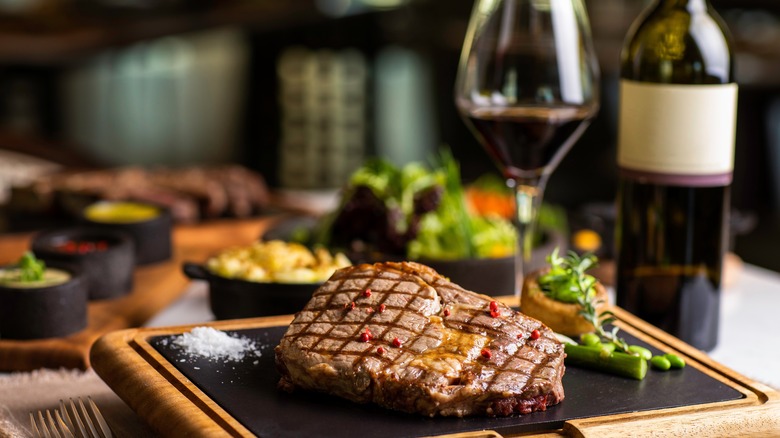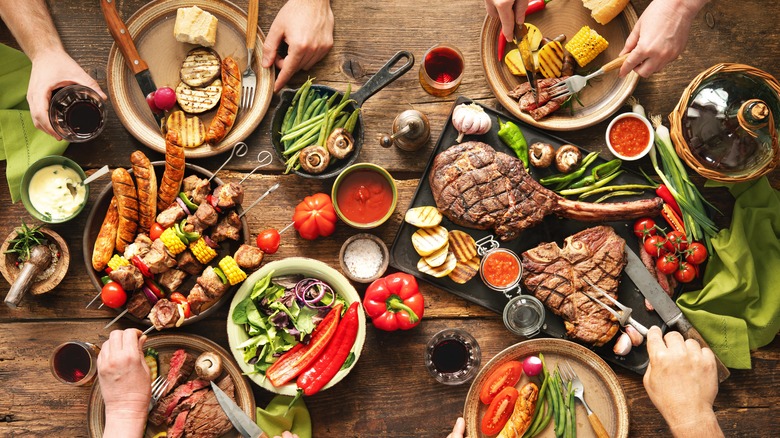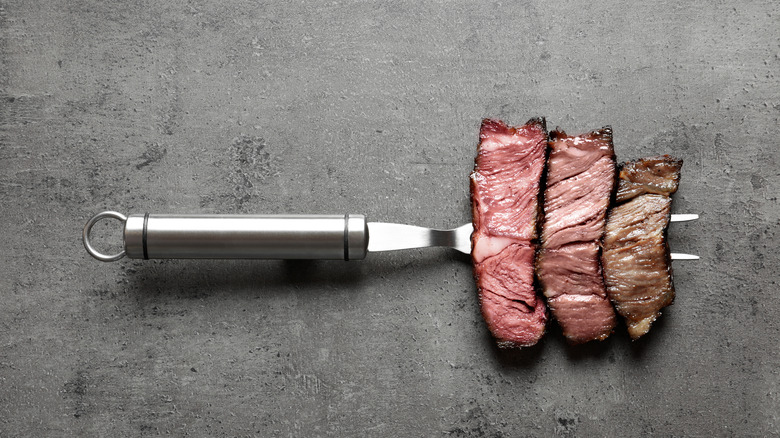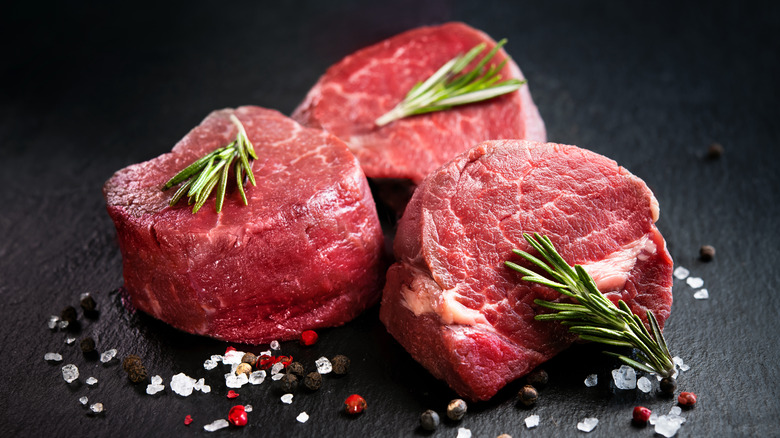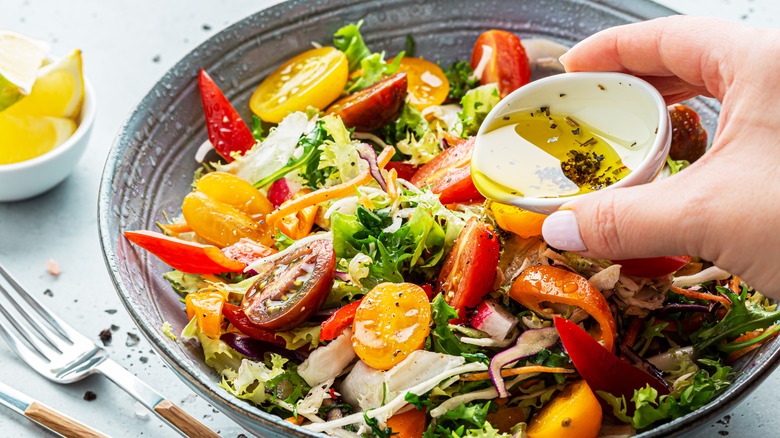11 Things You Should Never Do When Ordering Steak
For most of us, a meal at a steakhouse is reserved for special occasions and can mean a brilliant night out with family or friends. However, after much anticipation leading up to the event, you may find ordering your steak to be somewhat daunting — the menu might be extensive, for instance, and some varieties of steak may be unfamiliar to even long-time steak enthusiasts. There is a lot to consider, from navigating the multitude of cuts to choosing between wet and dry aged to pairing the perfect bottle of wine with your delectable steak.
The meal is likely to be an expensive one, so you want to make sure it's worth every penny, and that you leave satisfied. Join us as we unveil some of the mystery of ordering steak — we'll break down the jargon, and help you feel confident before you arrive at the restaurant.
Whether you're an experienced meat-lover or steakhouse novice, understanding this type of establishment can enhance your dining experience. Let's explore 11 things you should never do the next time you order steak.
Don't overlook the importance of the cut
The cut of steak you order is probably the most important factor in making your meal unforgettable. If you are not familiar with different cuts of meats, it is worthwhile spending time considering this before arriving at the restaurant. This way, you will have a rough idea of the best cut to order. For most people, the choice of cut comes down to a balance between flavor and tenderness, though the price of the steak may be a factor too.
If flavor is what you want most from your steak, rib-eye is the perfect choice. Cut from the rib section of the cow, it has marbling of fat throughout, keeping it full of beefy flavor. The high fat content means that ribeye is not the best steak to order rare, as cooking the meat for longer allows the fat to melt, improving the flavor further. Other cuts that are rich in flavor include New York strip (also known as top loin) and rump, which is full of flavor but less tender due to the muscles being used more.
If tenderness is your priority, then the filet mignon should be your go-to cut. Though more mildly flavored than some other cuts, filet mignon is from the tenderloin and, when cooked perfectly, should melt in your mouth.
And if you can't decide between flavor and tenderness, consider ordering the t-bone. This cut consists of both striploin and tenderloin, separated by a bone, giving you the benefits of both cuts.
Never bypass less common cuts
While striploin, filet, and ribeye get the most attention when it comes to cuts of steak, there are lesser-known cuts that definitely deserve your attention before you order a meal. Though the popular cuts have earned their reputation as steak royalty, choosing a steak outside your usual comfort zone may open up exciting culinary possibilities. In addition, less common cuts can be a cheaper option, as well as offering a unique flavor.
Hanger steak is an underrated cut that is positioned between the rib and the loin. It is known as the "butcher's cut" since it was originally the cut the butcher kept for himself, and for good reason. It has a great depth of flavor and can actually be really tender when cooked correctly.
Flat iron is another steak that is a great balance between cost and quality. Named after its resemblance to a traditional clothes iron, flat iron steak comes from the shoulder of the cow and has a deep, meaty flavor — though it may not be as tender as some of the premium cuts.
Bavette steak, also known as flank steak, is a popular cut in restaurants in France, served as the famous steak frites. An economical cut, it is difficult to cook correctly at home and can result in a tough piece of meat. However, if the chef really knows their cuts — and they should — ordering the bavette could result in a delicious meal for a much lower price than you may expect.
Don't ignore the grade of beef
When treating yourself to dinner at a steakhouse, the cut of beef you choose is certainly pivotal to the enjoyment of your meal, but there are other factors to consider. The grade of beef also plays a role in determining the quality and flavor of your steak.
In the United States, beef is graded by the U.S. Department of Agriculture into three main categories that signify the quality of beef. Prime beef stands at the highest level of this grading system. Most often found in steak restaurants, it is derived from young, healthy cattle and has plenty marbling of fat.
Following Prime beef is Choice grade. It has less marbling but remains a quality grade of meat and, when handled by a skilled chef, should still result in a juicy steak, especially from the tender cuts. Other cuts would be better roasted or braised.
Select beef has less fat than the other categories, so it may have less flavor and juiciness in comparison. Standard and commercial beef grades are also available but are not high-quality and are unlikely to be sold in a steakhouse. If you are looking for the highest possible quality steak, check the menu for Prime beef or ask your server if you need clarification on the grade.
Don't neglect attention to the beef's age
Another factor that will affect the flavor of beef is its age. This has nothing to do with the age of the cow, but refers to the length of time and method of storing the beef before serving. Wet aging is the most common method and involves the meat being vacuum-packed and stored in its own juices for around three weeks at 35 degrees Fahrenheit. Wet-aging suits lean cuts of meat, such as filet mignon and flat iron steak, and produces a juicy steak with a fresh flavor.
Dry-aged meat, on the other hand, is stored in a controlled environment and exposed to the air, where the enzymes are allowed to start breaking down the meat, intensifying the flavor of the beef. Dry-aged beef has a much stronger, more intense flavor than wet-aged — and it's prized by some steak enthusiasts.
So which is better, wet-aged or dry-aged? Well, like most debates in the culinary world, that decision is personal. Wet-aged beef has a traditional beefy flavor and a moist texture, whereas dry-aged has a stronger, more savory flavor with a firmer texture.
Ultimately, an experienced chef should be capable of cooking both types of meat perfectly, meaning whichever variety you choose, you should be treated to a delectable steak.
Don't fail to consider a bone-in steak
When trying to decide which cut to order, it is easy to be pulled toward the popular boneless steaks on the menu, especially ones you would usually order. However, overlooking the bone-in steaks may mean you are missing out on a new steak-eating experience.
Most chefs believe that leaving the bone in a steak, or any meat, results in a tastier dish. This could be because the meat near the bone cooks more slowly, resulting in a juicier texture, which is great if you have ordered your T-bone medium or well-done. However, a rare steak may not benefit in the same way, and the bone-adjacent meat may be raw.
Many chefs also believe that the marrow from inside the bone leaks out during cooking, providing a buttery liquid that soaks into the beef. However, there is no concrete evidence that this occurs as the collagen between bone and meat would likely prevent it from passing through.
Another great reason to choose a bone-in steak is to give you the benefit of two cuts of steak on one plate. A T-bone steak has the tenderloin on one side and striploin on the other, giving you the perfect steak-lovers meal. A Porterhouse steak is similar to a T-bone but contains more of the prized tenderloin, making it a much more expensive option.
While there are many delicious boneless steaks on offer, considering a bone-in steak on your next visit may enhance your dining experience in a surprising way.
Never choose certain side dishes
While steak is definitely the main attraction on your visit to a steakhouse, choosing the right side dishes can elevate your meal from good to outstanding. The best accompaniments to complement the flavor of steak can make a big difference to how satisfied you feel while eating your meal.
Most people include a potato dish alongside their steak, but with many options available, which one should you choose? You may wish to consider how filling your steak will be and base your choice on that. A baked potato is a lovely, comforting accompaniment to a steak, especially a smaller steak that is simply grilled with no heavy sauce. Gratin potatoes are also an excellent addition but are rich and indulgent. If you order a more filling cut of steak, you may prefer a lighter option, such as sweet potato fries.
As great as a classic portion of potatoes is, there are many other dishes that make a tasty side to a steak. Crispy onion rings give a satisfying crunch to balance the soft, melt-in-your-mouth meat, as will roasted Brussels sprouts. For a smoother texture, creamed spinach or parsnip puree will work really well.
Also, bear in mind that steakhouse portions tend to be generous, and you may want to order a few sides for the table to share instead. It is also worthwhile checking with your server to find out if the steak comes with any garnish, such as roasted tomatoes or mushrooms, before ordering side dishes.
Avoid pairing with the wrong drink
Selecting the right drink to complement your steak is important when eating at a steakhouse. In the same way that a side dish can balance or overpower your main meal, the drink you choose to sip alongside it can affect how you enjoy the overall experience.
Red wine is a classic beverage that goes well with steak. As a rule, wines with high tannins are excellent with cuts that have a high fat content, whereas leaner cuts are better suited to a light wine. Although red wine seems to get all the attention when it comes to steak, white wine can make a perfectly good partner. Try a chardonnay, which should stand up well to the strong flavor of steak.
If you are a whiskey drinker, there are a few options that will complement your steak. For a high-fat cut such as ribeye, a smoky Scotch will be a good match. For leaner cuts like filet mignon, try a smooth bourbon.
If you are planning to order a cocktail with your steak, it is best to avoid sugary ones that will clash with the flavor of the meat. Instead, opt for classic cocktails such as a martini or old fashioned, as their deep flavors will provide a better match to the beef.
For a non-alcoholic beverage, avoid soft drinks or fruit juices, which will be too sweet. Instead, consider ordering sparkling water that will give your palate a refreshing lift.
Don't order too much
When you start perusing the menu at the steakhouse, it's easy to get carried away with what you are going to order. You may not have eaten much before your visit, and reading a menu when hungry can be dangerous. Steakhouse menus are large and filled with alluring appetizers and desserts, as well as the huge offerings of steaks and sides. While you may think you could eat the whole menu quite happily, ordering too much food can put a sour note on the evening, both for your stomach and your wallet.
When reading the menu, remember that you are there for the steak — to savor every bite of that perfectly chargrilled meat without feeling overly full. Leaving steak on your plate because you ate too much garlic bread would be criminal.
The next hurdle is the side dishes — only order one or two side dishes and make sure they complement your steak. If you order one side that is rich and heavy, make sure the other is light and fresh, or you will feel uncomfortably full at the end of your meal.
Finally, there is the dessert menu. If you finish your steak and don't have room for dessert, simply don't order it. Steakhouses tend to be expensive places to eat, so you don't want to be ordering food you can't manage. By planning in advance and resisting the urge to order everything that sounds good, you can leave the restaurant feeling sated, with no regrets.
Avoid ordering steak well done
This may be a controversial one, as how you like your steak is a personal thing — and you have the right to order it cooked as you like it. However, there are a few reasons why it is not a good idea to order a well-done steak at a steakhouse.
Eating at a steakhouse is a luxurious experience. Whatever cut of meat you order is going to cost more than your average meal out, so it makes sense to have your dish cooked to perfection. In a reputable steakhouse, the chef will be extremely knowledgeable about each cut of steak and how to bring out the best in it.
The longer a steak is cooked, the more the natural juices will be lost, and the texture of the meat will become firm. This leads to dry, chewy meat that is difficult to enjoy. No matter how high the quality is, cooking the meat above 160 degrees Fahrenheit will diminish the flavor and texture of the beef significantly.
If you are hesitant to order pink (or pink-ish) meat due to safety concerns, fear not. According to scientists at the University of Nottingham, even rare steak is highly unlikely to carry any food-borne bacteria, such as E.coli, as long as the meat is handled properly (via BBC).
While it's important to order a meal you will enjoy, trying your steak a little less cooked may open your eyes to a more spectacular steakhouse experience.
Don't believe the most expensive steak is the best
So now you know you've got all these factors to consider when ordering a steak — cut, grade, age, and cooking temperature. It may be tempting to think that instead of wading through the myriad of options, choosing the most expensive steak will be guaranteed to be the right choice. However, this is not always the case.
Many steak lovers assume filet mignon to be one of the best cuts of meat. Filet is among the most expensive steaks and a popular choice with many steak connoisseurs. However, lots of chefs believe this cut to be overrated. Although it is a very tender piece of meat, the flavor is slightly lacking when compared to a much cheaper cut, such as a flat iron or rump steak.
Unique cuts of meat, like Japanese Wagyu, also come with a hefty price tag, and although this is considered to be one of the best meats in the world, it may not be worth shelling out when other excellent steaks are available. A large portion of the price of Wagyu comes from import taxes and the cost of transportation, so choosing a locally bred steak may represent a better balance of flavor vs. cost.
Although a trip to the steakhouse is an opportunity to spoil yourself, you don't necessarily have to break the bank to cover it. There will likely be a delicious steak on the menu that will suit your budget, so choose carefully.
Never assume a side salad is a healthy option
If you are looking to order something other than steak on your trip to the steakhouse, you may be considering choosing a salad as a light, healthy option. However, it's wise to consider what the salads actually consist of.
Steakhouses are known for rich, indulgent plates of food and generous portions, so it is safe to assume that salads may follow these same rules. If you are trying to keep the calorie count low, there are a few classic salad components that may scupper your good intentions.
There is a reason the dressing makes a salad taste so good — they are often filled with sugar and fat, making them an almost invisible source of significant extra calories. Blue cheese and bacon are two other culprits that can sneak their way into a supposedly healthy salad without you realizing the damage they may do to your waistline. If you are set on having salad instead of steak, check the menu carefully for ingredients and ask the waiter to confirm if you are unsure. You can always request to omit any ingredients.
If you want to stick to your healthy eating program at a steakhouse, think carefully about what you will actually be eating. A plain, chargrilled steak with veg on the side may just prove to be a better option than the house salad.

